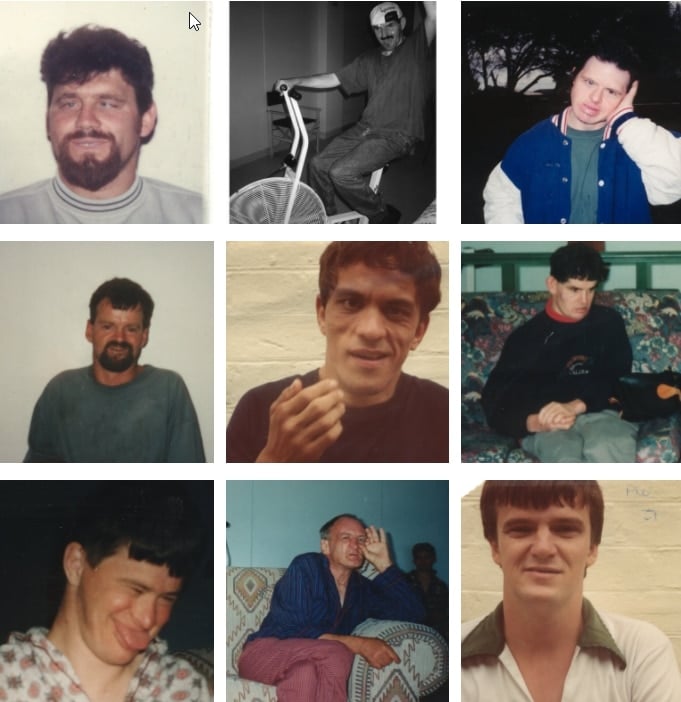
Spanish philosopher George Santayana famously said, “Those who cannot remember the past are condemned to repeat it.” It seems that with the implementation of specialist disability accommodation, we have failed to learn from history regarding the safety of People with disability.
Fire traps are being built for people with disability.
What is the History of Kew Cottages
View the Kew Cottages history in brief
In April 1996, a devastating fire at Kew Cottages, a residential facility for individuals with intellectual disabilities, tragically claimed the lives of nine men. The fire spread rapidly and violently through their unit. This raises an important question: Are the Specialist Disability Accommodations (SDAs) we are constructing today truly different and safer?
When I first arrived on the scene, I heard a whole lot of screaming … they appeared to come from the area that we were trying to attack, it was beyond the area that we could access … I was unable to get beyond the door at the end of the small corridor and it appeared this was the main area of the fire and the area where the screams came from.
The Coroner determined that all nine men succumbed to carbon monoxide poisoning and burns. According to a report by the Metropolitan Fire Brigade (MFB), the men perished within six minutes and 30 seconds of the fire’s ignition. Given that the fire alarm was not activated until seven minutes and 45 seconds later, it is likely that the cries Michael heard did not come from those who had already died.
The Fire in Detail
Ronald, Adrian, Thomas, Bruce, Stanley, Alan, Shayne, Peter and Joseph’s deaths are forever remembered in a memorial in the old grounds of Kew Cottages.
On the evening of 8 April 1996, a fire occurred in Flat E, Unit 31 of Building 37 at Kew Residential Services.
Tragically, the fire took the lives of nine intellectually impaired residents who required a high level of person-to-person support.
The investigation found the one constant is that such residents should be protected from the devastating effects of fire by the government and that that protection should have been in place to prevent the tragic events before they occurred.
The chapter, ‘Walking Ghosts’, from the book Bye-bye Charlie: Stories from the Vanishing World of Kew Cottages, written by Corinne Manning, UNSW Press 2008. Click here to read the full chapter.
When you realise how quickly it happens and what a violent event it is, it makes people realise how these things could have happened
It’s not something that took three quarters of an hour or an hour, where people would have had plenty of warning, it was all over in a few minutes
For ten years (since 1986), the State of Victoria had been given warning after warning by consultants, experts, personnel and different government instrumentalities as to the inadequacy of the fire safety system at Kew Residential Services.
Kew Cottages lacked sprinkler systems, a situation mirrored by many of the Specialist Disability Accommodations (SDAs) being constructed today. Alarmingly, some SDAs are being built up to three stories high without sprinklers. How is this allowed? Have we not learned from the Kew Cottages tragedy that the absence of sprinklers can be fatal?
Download free Personal Emergency Evacuation Plan PEEP Templates
SDA funding is only provided for participants who meet the eligibility criteria. Participants who meet the eligibility criteria will have an extreme functional impairment and/or very high support needs.
Incorrect Assumption
- Whilst Fully Accessible & High Physical Support cater for people that use wheelchairs and will generally require assistance to evacuate.
- Participants within the Improved Liveability and Robust categories whilst not using wheelchairs will in most cases still require assistance to evacuate due to cognitive, intellectual, neurological and learning disabilities or they will move slowly due to physical disability such as using crutches or walking frame.
- It is not satisfactory for certifiers, fire engineers to accept that people in Improved Liveability and Robust can self evacuate.
Why should all four categories of SDA be built as Class 3(7) Residential Care Building
A Class 3 — the building is a residential building providing long-term or transient accommodation for a number of unrelated persons, including the following:
- A boarding house, guest house, hostel, lodging house or backpacker accommodation.
- A residential part of a hotel or motel.
- A residential part of a school.
- Accommodation for the aged, children, or people with disability.
- A residential part of a health-care building which accommodates members of staff.
- A residential part of a detention centre.
- A residential care building.
To answer this question, we must refer back to the Pricing Arrangements for Specialist Disability Accommodation to understand who SDA is provided for.
SDA funding is only provided for participants who meet the eligibility criteria.
Participants who meet the eligibility criteria will have an extreme functional impairment and/or very high support needs.
It is not just required for people who use wheelchairs that cannot self-evacuate in fully accessible and high physical support categories. This is because of the range of disabilities all participants may have:
- Physical – wheelchair users, amputees, ambulant, etc:
Participants will not be able to evacuate downstairs independently or may take a lot longer to evacuate due to their disability or because they use a walking frame, crutches or other mobility aid.
- Intellectual – autism, down syndrome, etc: Maybe able to
- Psychiatric – schizophrenia, depression, etc.
- Neurological – epilepsy, acquired brain injury, Parkinson’s disease, MS
- Learning disabilities – dyslexia, dyscalculia, dysgraphia
Participants may not react to smoke and fire alarms, either delaying their evacuation or not knowing they need to evacuate.
- Sensory – hearing, vision, touch
Participants may not react to smoke and fire alarms due to deafness or participants with low vision cannot find their way out of a building due to low lighting levels.
NOTE: Remember, some participants will have multiple disabilities.
Provision of Sprinklers.
Table E1.5 Requirements for Sprinklers
| Occupancy | Where sprinklers are required |
| Class 2 or 3 building (excluding a building used as a residential care building) and any other class of building (excluding a building used as a residential care building) containing a Class 2 or 3 part. | Throughout the whole building, including any part of another class, if any part of the building has a rise in storeys of 4 or more and an effective height of not more than 25 m. |
| Class 3 building used as a residential care building | Throughout the building and in any fire compartment containing a Class 3 part used for residential care. |
As a BCA Class 3(7) Residential Care Building is the only classification that mandates sprinklers to all parts of the buildings no matter the size up as Class 2 and remaining Class 3 buildings do not require sprinklers until the building has a rise in storeys of 4 or more and an effective height of more than 25m.
This is the only way safe specialist disability accommodation can be provided.
But Australian Design Standards are Safe and World Leading, aren’t they?
What Does a Fire Rating Cover?
If a building has a 60-minute or 90-minute fire rating, what does that actually mean?
- Either you have 60 or 90 minutes to get out safely or
- You have minutes to get out before the building becomes smoke-filled, however, the building will remain structurally adequate for 60 or 90 minutes
Sadly it is the latter, again compromising the life safety of people with disability.
Who is Responsible to Evacuate Participants?
What Role Should Onsite Overnight Assistance Provide (OOA) During Evacuation?
The primary role of an OOA is the delivery of care
- Getting in or out of bed
- Personal Care
- Turning and repositioning
- Medication and pain relief
- Hydration and nourishment
- Temperature regulation
- Reassurance and Emotional support
- Supervision and safety
In my opinion, the OOA should not be responsible for emergency evacuation.
- OOA’s have the same right to get out of a building in an emergency as any other occupant.
- If there are multiple occupants in an SDA why should an OOA chose who to evacuate and in what order? This is further exacerbated based on the ratio of one OOA managing 10 SDA apartments.
- OOAs do not have emergency evacuation training.
Who other than Emergency Services should evacuate SDA Participants?



